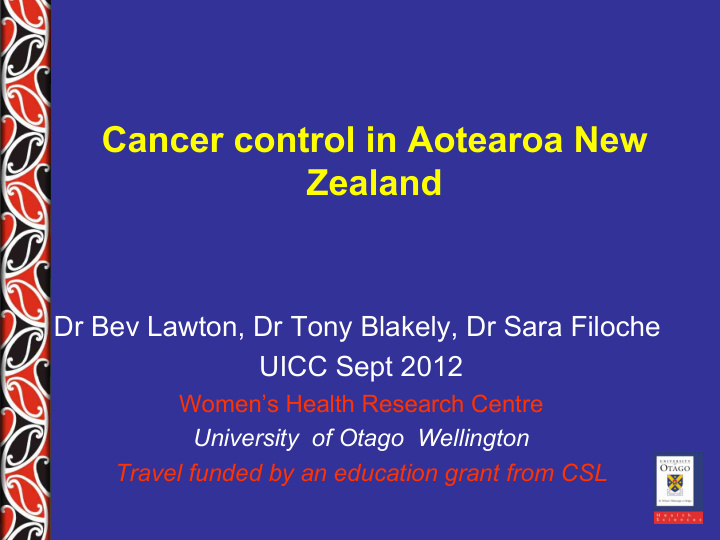



Cancer control in Aotearoa New Zealand Dr Bev Lawton, Dr Tony Blakely, Dr Sara Filoche UICC Sept 2012 Women’s Health Research Centre University of Otago Wellington Travel funded by an education grant from CSL
Overview • Cancer Control in Aotearoa • Inequalities for Maori • Barriers to equitable health • 2 case studies • Last thoughts
Health System • Largely free Public system runs concurrently with a private fee for service system • There is substantial input of NGO’S in the cancer health sector
NZ Cancer Control Strategy • Two purposes: 1. To reduce the impact of cancer 2. To reduce inequalities in the impact of cancer • Six Goals: 1. Primary Prevention 2. Screening and early detection 3. Diagnosis and treatment 4. Support, rehabilitation and palliation 5. Delivery of services (workforce, M ā ori, consumer) 6. Research and surveillance
• Independent, reporting to and advising the Minister • Five terms of reference: • Monitor and evaluate implementation of CCS • Independent strategic advice • Foster collaboration in sector • Foster and support best practice • Maintain international linkages
Inequalities for M ā ori • M ā ori are the Indigenous people of New Zealand and make up 15% of the population • M ā ori adults have 19% higher rate of diagnosis of cancer than non-M ā ori and a 78% higher risk of death from cancer • More likely to be diagnosed at a later stage. Stage does not account for all inequalities • (Robson, Purdie, & Cormack, 2010)
Bad news: Percentage difference in cancer excess mortality between M ā ori :non-M ā ori, patients diagnosed 1991-2004 Non-M ā ori have poorer M ā ori have poorer survival Percentage difference survival Oesophagus Testis Cervix Uterus Kidney Melanoma Prostate Head, neck and larynx Breast (female) Colorectum POOLED ESTIMATE Non-Hodgkin's lymphoma Liver Lung Stomach Leukaemia Hodgkin's lymphoma Pancreas Ovary Bladder Brain Thyroid gland -40% -30% -20% -10% 0% 10% 20% 30% 40% 50% 60% 70% 80% 90% 100% Source: Soeberg, Blakely, Sarfati et al. 2012. Ethnic and socioeconomic trends in cancer survival, New Zealand, 1991-2004
Figure 1: Cancer registration and death age-standardised rates by deprivation decile 2002-2006 (from Robson et al 2010)
Breast cancer incidence rates Suggestion survival gaps by ethnicity widening faster than incidence gaps Breast cancer mortality rates by ethnicity NZCMS and CancerTrends (Incidence) findings 9
Inequities are differences which are • Unfair • Avoidable • Fixable • Privilege
System/ Provider are the problem not the patient Eliminate Victim Blaming approach “Maori are more likely to die of cancer because they have cultural problems” “eating problems, self control problems, smoking problems, genetic problems, . . too shy, too lazy, fatalistic”. “Then they present late, don’t take their meds”
Triple A Q • Available • Accessible • Appropriate • Quality • Apples and pears
Case study 1 • Rural, coastal, 90 % Maori community in the Eastern Bay of Plenty (220Km) • Participation rate in mammography increased from 45% in 2003 to about 98% in both 2005 and 2007. • Breast Screen Aotearoa • Mobile breast screening unit Thomson NZMJ 2009
How did they improve access • Te Wh ā nau ā Apanui Community Health Service (‘TWAACH’, ‘the Service’) • Increased local involvement • Consulted community re barriers • Facilitated the provision of information about and promotion of breast screening, • Improved the identification of eligible women, and
Changing the system • Clinic took over enrolments and appointments • Group bookings and transport • Master list on the wall of surgery • Champions • Active promotion at community events, store pub • Cup of Tea, a small gift
HPV vaccination program • Use of a Maori Equity Advisory Group (MEAG) as an equity tool • Input at multiple levels- program policy, implementation plans and media • Issues :Community consultation and financial drivers • Rates of vaccination high for Maori compared to European 65% vs 46%
Conclusion • Significant inequalities in Cancer exist in New Zealand • The gaps may be widening • Innovative programs are being undertaken
Last thoughts • Indigenous Community involvement at the beginning • Eliminate the silence –put indigenous health upfront from policy to the cliff face • Racism • Champions
• Globally we need to make make the case that prioritising the health of indigenous peoples is cost effective • Call to action – we need to be visible with our messages as our people are dying
He aha te mea nui o tenei ao? Maku e kii atu, He tangata, he tangata, he tangata ! You ask what is the most important thing in this world? I will tell you: It is people, it is people, it is people! Kia Ora Thank-you Bev.Lawton@otago.ac.nz
Recommend
More recommend